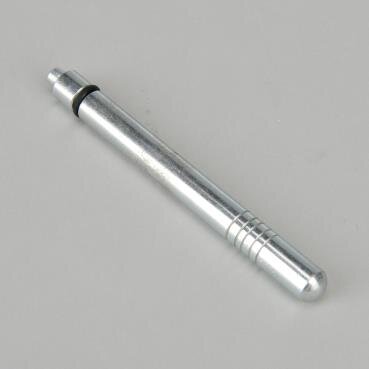Sorry, I may have missed something when reading this thread.
Things to check:
1. Does your master cylinder hold pressure? If it is not, your trouble shooting effort will be in vain. New master cylinders can be bad from the manufacturer.
While bench bleeding the master cylinder, plug both outlets of the master cylinder with plugs. Hopefully some good ones are included in the kit as the 9/16-18 plug for the front port might be hard to find. The rear ½-20 plug should be easier to find.
https://www.speedwaymotors.com/Master-Cylinder-Plugs-1-2-20-9-16-18-Zinc-Finish,239113.html
https://www.jegs.com/i/RPC/707/R3599/10002/-1
https://www.amazon.com/Racing-Power-R3599-Inverted-Flare/dp/B00IABEH7I
https://www.tuckersparts.com/inverted-flare-plug-9-16-18.html
- Clamp MC in a vice level to the ground.
- Install plugs in outlets
- Fill MC with Fluid
- Cycle the master cylinder with a rod.
MC piston should become rock hard with little to no movement. If you have substantial movement, there is air in the master cylinder.
If there is movement, hold pressure on the master cylinder piston with the rod. Crack open the plugs to release the air and then tighten them back up before you release the pressure on the piston. Once the plugs are closed and seated, release the piston and check to see if the master cylinder piston is rock hard with little or no movement.
If the master cylinder piston is rock hard with little to no movement, then it has NO air and is should supply the pressure the brake system needs. You can then rule out the master cylinder being the issue.
2. Rear drum brakes require a prop valve with a 10lb residual valve built into it or an inline 10lb residual valve. From the factory, all g-bodies came with a prop valve with a 10lb residual valve built in for the rear drum brakes. This is called a disc/drum prop valve. Disc/disc prop valves do not have the 10lb residual valve. If you don’t have a 10lb residual valve somewhere in the rear brake lines, you will have a low pedal.
3. Make sure the rear shoes are adjusted out against the drums. The rear shoes should self adjust when you brake in reverse and adjust closer to the drum. If there is a lot of distance between the rear shoes and the drum, then you will have a low pedal.
4. A vacuum booster has two push rods. One push rod is connected to the brake pedal and goes into the back of the vacuum booster. Make sure the hole in the push rod has the same diameter as the pin on the pedal. This will cause excessive play and will give you a longer pedal travel. The other push rod comes out of the booster and this is the one that contacts the master cylinder piston. If this push rod is too long, then it may preload the master cylinder piston and cause brake drag. If this piston is too sort it will give you excessive pedal travel. Most GM cars and trucks in the 80s has a shallow divot in the rear of the master cylinder piston. Usually this divot is roughly the same size and depth, so this is usually not an issue with the second push rod coming out of the vacuum booster. But the push rod coming out of the master cylinder needs to be the correct length for the booster and if too short, you will get excessive pedal travel.
Going from a ¾” wheel cylinder to a 1” bore wheel cylinder is not as big of a deal than going to a rear disc conversion with calipers that have pistons of around 2.0” or more in some cases. That is where substantial additional volume is required. A ¾” bore wheel cylinder has a piston area of .44 square inches which is minimal. A 1” bore wheel cylinder has a .785 square inches of piston area. Though almost double the ¾” bore wheel cylinder, the amount of fluid is still minimal. Most mid 80s rear calipers have 48mm single piston calipers, which is about 1.9 inches in diameter. The piston volume of these calipers are 2.8 square inches of piston area. That is 3.5 times the piston area of the 1” bore wheel cylinder and that is a lot more fluid to move, but a stock, step bore master cylinder should still handle the volume, but your brake pedal stoke will be a little longer.
A. Make sure your master cylinder holds pressure and has no air in it.
B. Make sure you are running a 10lb residual valve for the rear drum brakes.
C. Make sure your brake shoes are adjusted out against the drums.
D. Make sure you have the correct length push rod coming out of the vacuum booster.
Concentrating on A-D above should rule out all of your issues, unless there is air in the system somewhere. That should be the only thing left to deal with.



